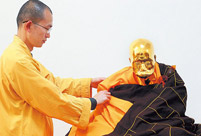

The book is not easy to understand or decipher, as it uses archaic words and ancient expressions for directions. But once the "code" is cracked, its accuracy is unquestionable.
Fu Shibao, an officer at the border police station in Tanmen, said there used to be at least 1,000 such books in the seafaring town.
"Now there are only about a dozen books left," said Fu, who has been helping Hainan University to study and protect the remaining books. He said the true value of the books was realized after friction between China and the Philippines over Huangyan Island escalated sharply in 2012.
Zhou, who has studied genglubu for 26 years with his wife, said that a book provided by former sea captain Peng Zhengkai records 17 routes to the Xisha Islands and more than 200 routes to the Nansha Islands. This book also contains many other details, including the weather conditions and ocean currents for every month.
Fishermen in ancient times named 136 islands and reefs in the books for China, much earlier than they were named by other countries, Zhou said.
Many of the names are still used, and nine of them have become official names in English. The Paracel Islands, for example, are named from a Portuguese word meaning "stone reef", which originally comes from the Chinese.
There are 287 named locations in the South China Sea. Zhou said the ancient Chinese did not name the others because many of them are submerged or partly submerged banks.
Genglubu date to the Ming Dynasty (1368-1644), he said, adding, "We are the earliest owners of the South China Sea."
He said the routes, along with China's historical documents, archaeological discoveries and accounts from old seafarers and fishermen show that "waters around the Dongsha, Xisha, Zhongsha and Nansha islands had become fixed fishing grounds for Chinese fishermen in the Ming Dynasty".
 |
 French girl ties the knot with Chinese boy
French girl ties the knot with Chinese boy Beijing Style: ready for bare legs
Beijing Style: ready for bare legs Century-old station sees railyway evolution
Century-old station sees railyway evolution Enthusiasts perform Kung Fu at Wudang Mountain
Enthusiasts perform Kung Fu at Wudang Mountain Stunning photos of China's fighter jets in drill
Stunning photos of China's fighter jets in drill Monk's mummified body to be made into a gold Buddha statue
Monk's mummified body to be made into a gold Buddha statue Former Chinese solider of the French Foreign Legion seeks wife online
Former Chinese solider of the French Foreign Legion seeks wife online Asia's longest and highest suspension bridge to open to traffic
Asia's longest and highest suspension bridge to open to traffic China's first interactive robot looks like a beauty
China's first interactive robot looks like a beauty Top 20 hottest women in the world in 2014
Top 20 hottest women in the world in 2014 Top 10 hardest languages to learn
Top 10 hardest languages to learn 10 Chinese female stars with most beautiful faces
10 Chinese female stars with most beautiful faces China’s Top 10 Unique Bridges, Highways and Roads
China’s Top 10 Unique Bridges, Highways and Roads Hong Kong opposition should seize the moment
Hong Kong opposition should seize the moment Trump’s anti-immigrant rhetoric strikes a chord with Chinese Americans
Trump’s anti-immigrant rhetoric strikes a chord with Chinese Americans China rejects latest US steel measures
China rejects latest US steel measures Is the wage gap between expats and locals a function of the market – or plain old discrimination?
Is the wage gap between expats and locals a function of the market – or plain old discrimination?Day|Week